| WOOD |
|
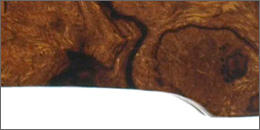 |
Desert Ironwood comes from Arizona and Northern Mexico, from the lower reaches of the Sonoran desert. It is very hard, very dense, and is one of a handful of woods that sinks in water. Ironwood also features some of the highest contrast and striking patterns of any wood in the world. Once used by the Seri Native Americans of Mexico for tool handles, we proudly offer premium grade ironwood on a variety of William Henry tools. |
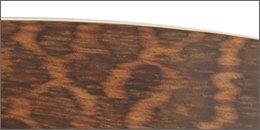 |
Snakewood. The name "snake wood" was clearly inspired by the snakeskin-like markings that decorate this exotic wood. Extremely hard and heavy, it is one of the most expensive woods in the world. We use only the finest snakewood, chosen for outstanding color and pattern. All William Henry's snakewood is resin-stabilized for durability. |
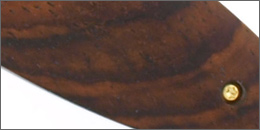 |
Cocobolo. One of the true tropical rosewoods, Cocobolo is a very beautiful wood, ranging from a beautiful rich dark brick red, to reddish or dark brown, with a figuring of darker irregular traces weaving through the wood. It is fine textured and oily in look and feel. Our premium Cocobolo comes from Mexico and Central America. |
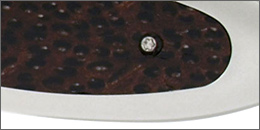 |
Black Palm. A beautiful and distinctive wood that is brown/black in color with a toothpick-like series of brown, black and white streaks running along the grain. On end, the grain is solid 'eyes' in a very compressed pattern. Mostly from Southeast Asia, but available from other parts of the world as well. We resin-stabilize our black palm for durability over time. |
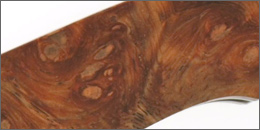 |
Amboyna Burl. A marvelously luxurious burl from Southeast Asia. It is very rare and desirable, and is one of the most expensive burls in the world. Amboyna varies in colors from yellow to brown to red, with tight wavy figure and 'eyes' with occasional black highlights. We resin-stabilize all our amboyna burl before using as a component in our work. |
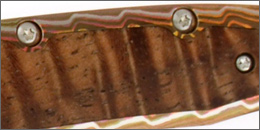 |
Koa is a fabled tree, and wood, from the Hawaiian islands. It is reddish brown in color, takes a beautiful polish, and can occasionally offer very fine figuring/curl and chattoyance. We use ONLY the highest grade of figured Koa (as available) for our work, resin-stabilized for durability. |
| |
|
| SEASHELL |
|
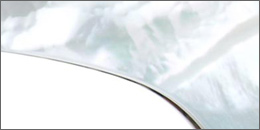 |
Mother of Pearl is the common name for iridescent nacre, a blend of minerals that are secreted by oysters and other mollusks and deposited inside their shells. We use premium mother of pearl material sourced directly from suppliers in Australia, selected for maximum color and figure. |
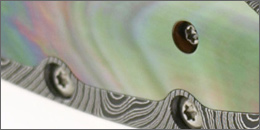 |
Blacklip Mother of Pearl is one of the most exclusive pearls in the world. It comes from small shells found in French Polynesia around Tahiti and its Archipelagos. Just under the exterior bark of the shell is where the real beauty of the Blacklip shell lies. A nice pair of Blacklip will have every color of the rainbow in its iridescent black background. We source our Blacklip directly from shell farmers in Tahiti to ensure sustainability and top quality material. |
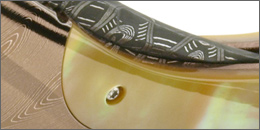 |
Goldlip Mother of Pearl is scientifically the same as White M.O.P. only that Gold is taken from the reverse side of the shell. Good quality dark Gold shells come from the waters surrounding the Philippines and parts of Indonesia. The gold section is a thin lip — like a veneer — of natural color that is carefully selected and worked to yield the deepest possible gold tones. |
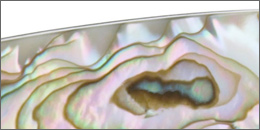 |
Abalone (from Spanish Abulón) is a rare shell found along the pacific coast of North America. There is a dwindling supply of shells large enough to create the scales we occasionally use in our knives, as these shells must exceed 7.5" in diameter. Most abalone trinkets are made from juvenile shells — these will not yield usable material for William Henry. A beautiful material when we can get it — all our pieces are cut from 'old stock' of harvested shells. |
| |
|
| FOSSIL MATERIAL |
|
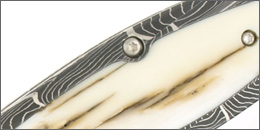 |
Mammoth Ivory defines the TUSK of wooly mammoth (and/or mastodon), occasionally found in Alaska and Siberia. Protected for millennia by the severe cold, this material makes beautiful handles and grips. The outer layer, called bark ivory, often has mineral deposits that create a range of colors; the interior is generally beige to cream color with fine grain patterns. We stabilize our material with acrylic resin to ensure its legacy in millennia to come. |
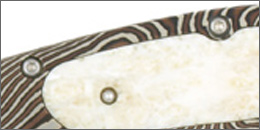 |
Fossil Walrus Ivory ranges from 6,000 to 10,000 years old, and is harvested from underground and underwater in Alaska and Siberia. William Henry works directly with Native Americans in Alaska who search for this exotic material during the 2-3 warmest months of the year. Minerals will seep into the material over time, creating colors from cream through the spectrum to blue/black in the exterior layers. Our material is air-dried for at least one year after harvesting, then resin-stabilized. |
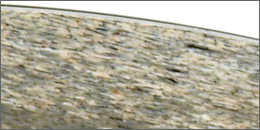 |
Wooly Mammoth Bone is fossilized (not petrified) bone material that ranges up to 10,000 years old. Natural colors range from tan to grey to occasional blues with a very fine grain, low porosity, and beautiful polishing characteristics. We resin-stabilize our mammoth bone before processing, and hand select for premium color and grain. |
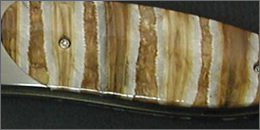
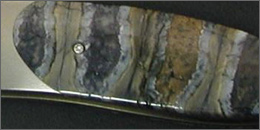 |
Mammoth Tooth is the most exotic of our fossil materials — it is literally the cross-section cut from the molar tooth of a wooly mammoth. Striations that alternate between quartz-like material and softer layers make mammoth tooth very challenging to work with. All our material currently comes from beneath the North Sea, available only occasionally, and must be air dried for at least one year before processing. We resin-stabilize each piece and use an impact-resistant backing to protect the material during processing and on the knife. |
| |
|



